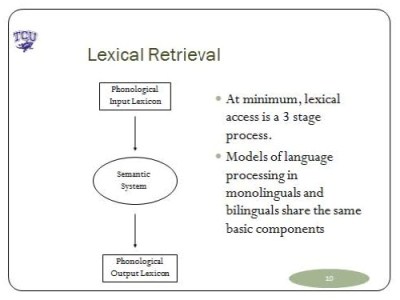This article is a written transcript of the course, “The Assessment and Treatment of Anomia in Spanish/Bilingual Aphasia”, presented by Maria Munoz, Ph.D. on May 9, 2011.
Communication access realtime translation (cart) is provided in order to facilitate communication accessibility and may not be totally verbatim. The consumer should check with the moderator for any clarifications of the material.
>> Amy Hansen: Good afternoon, everyone. Welcome to today's Expert e-Seminar, “The Assessment and Treatment of Anomia in Spanish/Bilingual Aphasia”, presented today by Dr. Maria Munoz. We're very pleased to have her with us this afternoon. My name is Amy Hansen and I'll be your moderator for today's online course. At this time, it is my pleasure to introduce Dr. Maria Munoz this afternoon. Dr. Munoz is an Associate Professor and Coordinator of the Emphasis in Bilingual Speech-Language Pathology Program at Texas Christian University. Dr. Munoz conducts research, publishes, teaches and provides clinical supervision in the areas of aphasia, the manifestation of aphasia and Spanish/English bilingualism and multi-culturalism. So welcome, Dr. Munoz, and thank you so much for joining us today.
>> Dr. Maria Munoz: Thank you. I'm happy to be here. I'll be honest and say this is my first online presentation so if I stumble a little bit, please bear with me. I'm used to looking at faces. Looking at a computer screen for me is a little odd because I cannot gauge what you all are thinking about what I'm saying. Let me start by asking just a couple of questions to get a feel for who is out there. So this is obviously a topic on aphasia, bilingualism and Spanish speakers and how many of you speak Spanish? Okay. That's fine. I'll gear it towards being accessible to monolinguals and bilinguals. So I'm assuming everybody works with adults? Okay, excellent. So I think this information will be real helpful for you. If we look at things, for example, that JACO is doing there really is increasing emphasis on providing culturally appropriate services and making sure that the functional outcomes we attain take into account issues relating to cultural and linguistic diversity.
So I'll start off with just a quick overview of lexical retrieval and I'm sure you're all familiar with that. I’ll talk about anomia and how it is similar to or different from what we see in English. Then I’ll talk about some specific assessment tools because I know that walking away with some resources is critical. So we'll look at kind of what is out there that you can already use. Then, finally, I’ll talk about some ways that you can modify existing treatments for use with bilingual and Spanish-speaking clients.
One of the things I want to do for both monolingual and bilingual clinicians is look at what you already know and build on it because you guys are all very knowledgeable in your field. I don't want to reinvent the wheel. I want to take the knowledge you already have and show you how you can transform it just a little bit and apply it across languages.
Lexical Retrieval
Let's talk about lexical retrieval. We come at it from a cognitive neuropsychological perspective. The idea when somebody has naming difficulties - not just can they name -but why are they having difficulty naming? One way we determine that is by understanding the process of lexical retrieval in general.

And we know that there are at least a minimum of three stages.
- One is the Phonological Input Lexicon. This is kind of our word shapes. So when we look at a word we don't always sound it out. We can look at it and recognize it. I'm sure many of you have seen that email that goes around occasionally that has all the vowels removed or the vowels reversed or substituted. But you could still recognize what it spells. You can still read the message because we can do a lot of recognition of shapes of words and that is the written correlation to our hearing of words. We recognize the shape of the word.
- When we hear that word it activates our Semantic System, our “conceptual store”. We understand the nature of the word or the object in the world. I used ‘dog’ a lot because I have two dogs and that is the word that comes to mind. Not just ‘dog’ but ‘dogness’: a four-legged animal; it barks and it has fur and it is a pet; all of those aspects that make a dog a dog.
- Then we have the Phonological Output Lexicon. It is our storehouse of word shapes for output. We know that there are differences at these levels because you can have a patient with difficulty comprehending a word but can produce word. You can have patients who know what they want to say but they just cannot say it and we have patients with dementia that lose the semantic knowledge.

